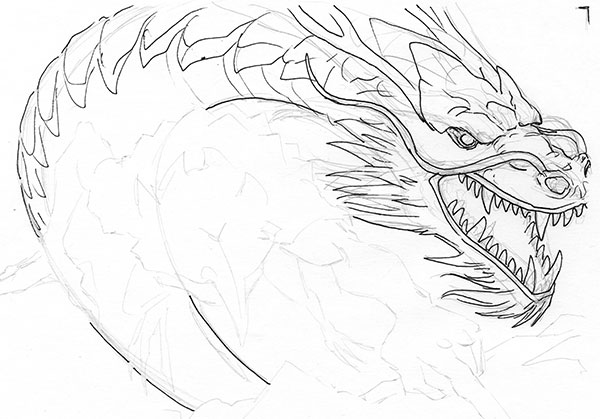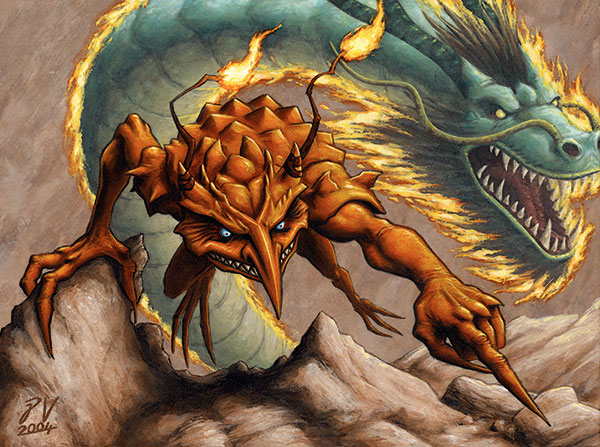Kiki Jiki – Upwardly Mobile
Kiki Jiki, Mirror Breaker (from Champions of Kamigawa) was originally assigned to me as ‘Goblin Illusionist’.
The card seemed a little out of the ordinary given that the art description asked for a capable magic-wielding goblin, as opposed to the multitude of goblins that use magic with the surgical precision of a trebuchet and usually end up getting nailed by their own devices.
The art description called for the goblin to summon a powerful illusory creature to fight at his side. Not wanting to overplay my hand, I chose one of the Kamigawa setting’s ogres which looked like real brutes (that’s a compliment) in the style guide, but fell short of being a genuinely big league monster.
Here’s the initial sketch, featuring Kiki leaping into action and commanding his creature to attack some off-screen enemy. The ogre is outlined in flame which was also a request of the art description, presumably as a hallmark of Kiki Jiki’s magic. However, it’s equally likely that someone was just uptight about the idea of red magic creating illusions and this effect was the compromise.

The feedback on the sketch was somewhat unexpected. They liked the goblin (or Akki as they were known in Kamigawa) but wanted the illusory creature to be bigger. Much bigger. Like a dragon. And when pressed, exactly like a dragon actually.
Clearly, this goblin had just received a promotion.
It’s not every day that the desired change to a Magic card amounts to “MOAR DRAGON”. Given the goblin’s unusual arcane prowess I’d already come to suspect that this card was a Rare, but after the requested revision, I was certain of it. Indeed, it might even be a power card. Yes, even if the art director doesn’t fill you in on the rarity, sometimes the way the art description is written or what elements are included can give you a pretty strong guess at the rarity of your card assignment.
Magic can be pretty tight-lipped about rarity these days. Sure, those rarities can change during the set’s development cycle but an initial idea of the rarity actually helps me make design decisions. But more about that in a later article…
Here’s an overlay, with a faint outline of Kiki which I built the dragon around.

This revision proved to be really beneficial for the image. The looped form of the dragon creates a nice sweep that leads your eye from the vicinity of Kiki Jiki’s trailing feet to the tip of the finger of his pointing hand. This helps with that sensation of movement through the piece and just makes the whole composition stronger. The ogre, whose form necessitated him being placed more to the side of Kiki, would have resulted in a much weaker image.
So, here’s the final painting of one of the most famous goblin cards I’ve done. It’s kind of ironic that the Akki were about the least goblin-like rendition of the goblin creature type in the history of Magic.

Also, Akki were devilishly difficult to get right as the contours of their head and shoulders were hard to keep track of. They would have benefited from a 3D rendition themselves.
In a way that happened, as Kiki Jiki (plus dragon) was made into a statue that was released around 2005. That makes Kiki one of three of my pieces that have been made into sculptures. The other two were Baron Sengir – an unpainted statue about seven inches high manufactured for the Japanese market around 1995 – and the Demon Token – which was made into an itty-bitty sculpt on top of a life counter.
Still, there’s a certain ‘traditional’ green-skin gobbo digital sculpture that I’m itching to show you more of in the very near future.
Later!

Very nice 😉